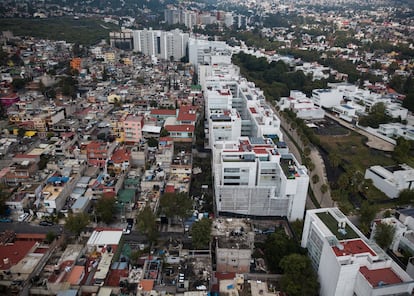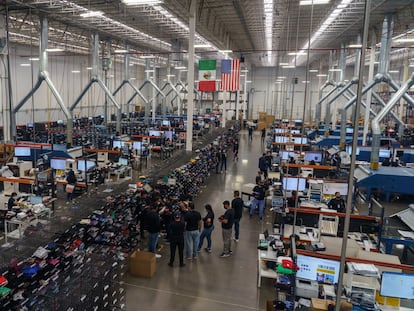How did Mexico reduce economic inequality?
There are three elements that have contributed to this reduction over the course of the past half-decade: higher incomes, a strong performance by small businesses and lower rental prices

Over the past six years, income inequality has been decreasing in Mexico. And this reduction isn’t minor. According to data from the National Survey of Household Income and Expenditures (ENIGH) — adjusted by national accounts — over the course of this period of time, the upper classes went from holding 62% of the country’s income to now holding 58%.
This is a very important drop. The last time the figure fell in a similar way was in the 1950s, during the time of the so-called “Mexican Miracle,” according to data from the World Inequality Database (WID).
The strange thing is that — unlike in the 1950s — this time around, the reduction in economic inequality wasn’t accompanied by especially high economic growth. Throughout this six-year term — while Mexico has been governed by President Andrés Manuel López Obrador (2018-2024) — the average annual growth has been only 0.8%, half that of the previous six-year administration. The question is: how was inequality reduced in these circumstances?
I analyzed the ENIGH data and its various income components in detail. I believe that there are three aspects that contributed to this important reduction in inequality during the six-year-long period.
First, we must consider labor policy. Due to the increases in the minimum wage, the bolstering of unions and the reduction of subcontracting, the labor income of Mexicans increased considerably. 80% of Mexican households saw increases in their labor income over the past six years, well above inflation.
Furthermore, the increases were greater for the poorest households. Households with a very low socioeconomic level increased their labor income by 19%, while those in the low-income strata increased it by 5%. This makes sense. The minimum wage is earned — above all — by people who come from the lowest socioeconomic strata. Therefore, its increase had a progressive impact.
Second, inequality was reduced because there was a change in the business ecosystem. Unlike in previous six-year administrations — where large companies tended to grow more and have higher returns — in this six-year-long period, small companies have had exceptional returns. 90% of households with income from small businesses increased their income since 2018.
Similar to labor income, the improvements were much larger for low-income households. Households with a very low socioeconomic level increased their small business income by 17%, while those with a low socioeconomic level grew it by 15%.
On the other hand, the income that the richest households received from their large companies fell. From 2018 to 2022, the reduction was 18%. For example, in 2018, the very rich reported receiving an average monthly income of 915,000 pesos ($53,500). Today, on average, they only receive 750,000 pesos ($44,000).
It will be necessary to dedicate further study to understanding why this happened, but it seems like the increase in social transfers may be behind it. Much of the money that low-income people receive from the government isn’t spent in large companies, but in small and informal businesses. This flow of resources may be behind the abnormally positive six-year-long term that small business owners have experienced in Mexico.
Finally, a third point that contributed to the reduction of inequality during the six-year term were the decreases in rents charged by households in the upper-middle-class and rich socioeconomic strata. According to the ENIGH, rich households used to receive 710,000 pesos ($41,500) per month in rental income on average in 2018. Today, they receive 590,000 pesos ($34,500). Households with a high socioeconomic level also had a slight reduction in this type of income. They used to receive 36,000 pesos ($2,100) in rent per month. Now, they receive 33,000 pesos ($1,900).
There are several aspects that could influence this. Perhaps the value of certain rents — especially when it comes to large-scale agricultural land — failed to rise as much as inflation did. Another possibility is that rental income has decreased across the board due to many people returning to their hometowns during the pandemic, leaving higher vacancy rates in cities. Covid also changed work habits: it made the home office possible for many more Mexicans and thus made it easier for certain professionals to no longer have to pay high rents in central locations. Rather, they were able to travel and pay less rent. All these possibilities will have to be studied in more detail.
Thus, inequality was reduced due to the combination of three aspects: higher labor income, the improved performance of small businesses and a decline in the amount of money spent on rent.
It’s still worth mentioning that inequality could have decreased even more had social policies been more effective. During the six-year-long term, cash transfers doubled. However, those who’ve seen the biggest increase in their receipt of transfers from the federal government aren’t poor households. On the contrary: the richest Mexicans benefited the most from subsidies.
The data is very revealing. Among households classified as being very low-income, funds from social programs increased by 17%. However, among those at a high level, these funds increased by 216%. This is explained because, before 2018, the richest Mexicans barely received any social transfers at all. But since then, social policies were universalized. As a result, many more high-income households — which were previously excluded from social programs — were reached. If social programs had reached more vulnerable citizens instead, inequality would have been reduced even further.
Sign up for our weekly newsletter to get more English-language news coverage from EL PAÍS USA Edition
Tu suscripción se está usando en otro dispositivo
¿Quieres añadir otro usuario a tu suscripción?
Si continúas leyendo en este dispositivo, no se podrá leer en el otro.
FlechaTu suscripción se está usando en otro dispositivo y solo puedes acceder a EL PAÍS desde un dispositivo a la vez.
Si quieres compartir tu cuenta, cambia tu suscripción a la modalidad Premium, así podrás añadir otro usuario. Cada uno accederá con su propia cuenta de email, lo que os permitirá personalizar vuestra experiencia en EL PAÍS.
¿Tienes una suscripción de empresa? Accede aquí para contratar más cuentas.
En el caso de no saber quién está usando tu cuenta, te recomendamos cambiar tu contraseña aquí.
Si decides continuar compartiendo tu cuenta, este mensaje se mostrará en tu dispositivo y en el de la otra persona que está usando tu cuenta de forma indefinida, afectando a tu experiencia de lectura. Puedes consultar aquí los términos y condiciones de la suscripción digital.
More information
Archived In
Últimas noticias
Maduro pleads not guilty before the federal court in New York: ‘I am still the president of Venezuela’
A new test can detect Alzheimer’s from a finger prick
UN team enters Sudanese city of El Fasher after paramilitary massacre: ‘It’s like a ghost town’
A recipe for resistance: Indigenous peoples politicize their struggles from the kitchen
Most viewed
- Gilles Lipovetsky: ‘If you want to live better and fall in love, take Prozac, don’t look to philosophy’
- Alain Aspect, Nobel laureate in physics: ‘Einstein was so smart that he would have had to recognize quantum entanglement’
- Alvin Hellerstein, a 92-year-old judge appointed by Bill Clinton, to preside over Maduro’s trial in New York
- Maduro’s downfall puts China’s relationship with Venezuela to the test
- Why oil has been at the center of Venezuela-US conflicts for decades











































